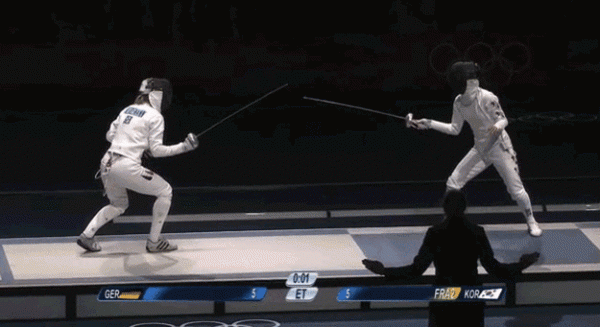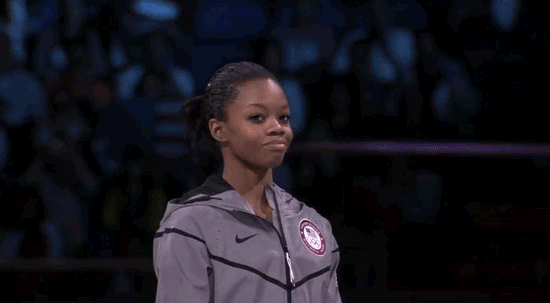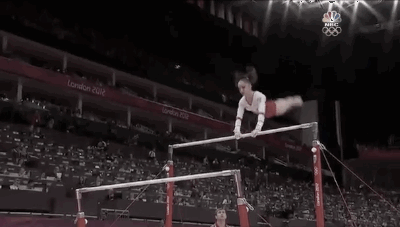
Did you hear about the Olympic fencer who refused to leave the piste after losing to a computer glitch? I didn’t watch it on television or on NBC’s web livestream, since I don’t have cable. But I did watch the next best thing — maybe the better thing: BuzzFeed’s strangely compelling and haunting recap, presented in videos, still images, and animated GIFs.
GIFs — the low-quality animated images that seem never to go out of style — have emerged as a new form of storytelling during the 2012 Olympics. And what better place to push the form than BuzzFeed? Deputy sports editor Kevin Lincoln has created an impressive oeuvre of GIF stories for the London Games, including one for that Korean fencer, Shin A Lam:
That story was a team effort between my editor, Jack Moore, and me. I noticed what was happening after the South Korean coach started protesting the end of the match, and we were discussing it, and rather than only pulling video of the controversial moments — which we also did — Jack thought it would be a good idea to lay out the narrative, since it was so interesting and bizarre. From there, we both pulled video and made GIFs and grabbed the best images from the wire and used all that to tell the story as best we could in a scrolling format.
Lincoln used an app called Snapz to capture the video from the live stream and then opened the resulting MOV file in Photoshop, isolating the frames he needed and saving the file as a GIF.
For each piece of the story, Lincoln selected the format best suited for the moment. To convey the devastation of a fencer alone on the piste, a still image worked best. For the chaos of the coach’s protest, the audience reaction, the drama of an athlete standing defiant, video was ideal.
“What GIFs do,” Lincoln said, “is sort of bridge the gap between an image and a video, which becomes incredibly useful in sports — you don’t have to wade through and listen to an entire highlight/video, but at the same time, you get the motion and action that makes sports sports.”
There is a lot of down time in sports that serves no useful purpose for the reader, Lincoln said: That story of the fencer played out over the course of an hour. GIFs allowed Lincoln to condense the story, “whereas in a video it would’ve been clumsy and hard to show,” he said.

Consider Lincoln’s roundup of the 25 most absurd moments of the opening ceremonies, which I would argue is more entertaining (and hilarious) than sitting through hours of the ceremony. For people who don’t have time, or don’t understand, or don’t have the attention span for the Olympics, GIFs are surprisingly information-dense containers.
Elspeth Reeve, a writer for The Atlantic Wire, is giving a BuzzFeed a run for its money with her explanatory GIF reporting. Last month, as Americans began paying attention to gymnastics again, Reeve wrote:
Gymnastics is one of those Olympics sports that lots of people watch every four years, meaning whatever happens during the competition is exciting and surprising but also confusing. Who are these women? Which one is the underdog? The veteran? Who is good at what thing? How can I tell when a flippy thing was good?
Reeve’s explainer was told in GIFs. GIFs in slow motion, GIFs in beautiful black and white, GIFs that zoom in on the action. What’s the better way to describe a “Pak salto to a stalder Shaposhnikova half” — words, or a moving image?

“I found they were perfect for explaining the sport to non-fans (my husband), because they isolate one trick. It makes it so much easier for the untrained eye to see how amazing each skill is,” Reeve told me.
SB Nation is doing it (Michael Phelps’ day in a single GIF). Business Insider is doing it (Ann Romney’s horse tap dancing). Even The New York Times is doing it, not for the Olympics but for its positively lovely Still Life series.
The GIF, invented by CompuServe in 1987, has many advantages over video: It requires no Flash and works in any browser on any device. It is silent, and therefore viewable in environments where sound is not available or desirable (i.e., the office). It’s incredibly shareable, as any visit to Tumblr will attest. And, perhaps most interestingly, a GIF is harder to take down than, say, a YouTube video, where one DMCA notice or the whim of the uploader can turn a video into a black void. (Try to watch this hilarious, adorable, RIDICULOUS video of U.S. gymnast’s Aly Raisman’s parents on YouTube, and you’ll get the dreaded “This video has been removed by the user.” Gawker was able to snag the video in a different format.)
“People aren’t quite sure about the rights involved with GIFs as a medium,” Lincoln said. Sports journalist Scott Lewis has reported the notoriously protective MLB is trying to crack down on GIFs within 48 hours of a game. (But “sports and animated GIFs were made for each other,” laments David Holmes of The Daily Dot.) Good luck with that.
Like any disruptive, creative medium, the GIF is easy to spread and difficult to control. The files are small; anyone can host them without relying on third-party servers. Most importantly, a GIF is a moving story compressed to its most essential form. If the 2008 presidential election was a coming-out party for Twitter, perhaps the 2012 Summer Olympics are the coming-out party for a 25-year-old file format.